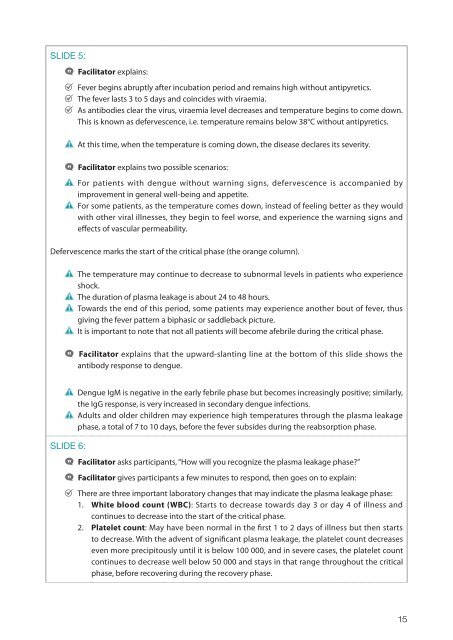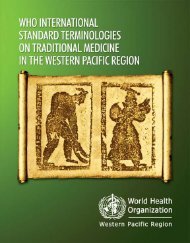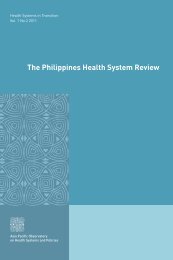Facilitator - WHO Western Pacific Region - World Health Organization
Facilitator - WHO Western Pacific Region - World Health Organization
Facilitator - WHO Western Pacific Region - World Health Organization
Create successful ePaper yourself
Turn your PDF publications into a flip-book with our unique Google optimized e-Paper software.
SLIDE<br />
• 5:<br />
•<br />
<strong>Facilitator</strong> explains:<br />
•<br />
•Fever begins abruptly after incubation period and remains high without antipyretics.<br />
•<br />
•The fever lasts 3 to 5 days and coincides with viraemia.<br />
•As antibodies clear the virus, viraemia level decreases and temperature begins to come down.<br />
•<br />
This is known as defervescence, i.e. temperature remains below 38°C without antipyretics.<br />
•At<br />
• this time, when the temperature is coming down, the disease declares its severity.<br />
•<br />
<strong>Facilitator</strong> explains two possible scenarios:<br />
•For patients with dengue without warning signs, defervescence is accompanied by<br />
•<br />
improvement in general well-being and appetite.<br />
•For some patients, as the temperature comes down, instead of feeling better as they would<br />
with other viral illnesses, they begin to feel worse, and experience the warning signs and<br />
effects of vascular permeability.<br />
Defervescence<br />
•<br />
marks the start of the critical phase (the orange column).<br />
•The temperature may continue to decrease to subnormal levels in patients who experience<br />
•<br />
shock.<br />
•The duration of plasma leakage is about 24 to 48 hours.<br />
•Towards the end of this period, some patients may experience another bout of fever, thus<br />
•<br />
giving the fever pattern a biphasic or saddleback picture.<br />
•It<br />
••<br />
is important to note that not all patients will become afebrile during the critical phase.<br />
<strong>Facilitator</strong><br />
explains that the upward-slanting line at the bottom of this slide shows the<br />
antibody response to dengue.<br />
• •Dengue IgM is negative in the early febrile phase but becomes increasingly positive; similarly,<br />
•<br />
the IgG response, is very increased in secondary dengue infections.<br />
•Adults and older children may experience high temperatures through the plasma leakage<br />
phase, a total of 7 to 10 days, before the fever subsides during the reabsorption phase.<br />
SLIDE 6:<br />
• • <strong>Facilitator</strong> asks participants, “How will you recognize the plasma leakage phase”<br />
• • <strong>Facilitator</strong> gives participants a few minutes to respond, then goes on to explain:<br />
• •There are three important laboratory changes that may indicate the plasma leakage phase:<br />
1. White blood count (WBC): Starts to decrease towards day 3 or day 4 of illness and<br />
continues to decrease into the start of the critical phase.<br />
2. Platelet count: May have been normal in the first 1 to 2 days of illness but then starts<br />
to decrease. With the advent of significant plasma leakage, the platelet count decreases<br />
even more precipitously until it is below 100 000, and in severe cases, the platelet count<br />
continues to decrease well below 50 000 and stays in that range throughout the critical<br />
phase, before recovering during the recovery phase.<br />
15

















